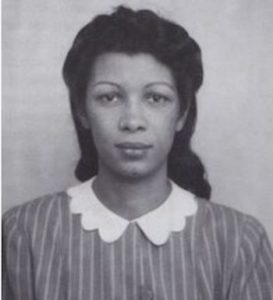
Rose Piper
*Rose Piper was born on this date in 1917. She was a Black painter best known for her semi-abstract, blues-inspired paintings of the 1940s.
Rose Theodora Piper was born Rose Theodora Sams in New York. She grew up in the Bronx, where her father taught Latin and Greek as a public school teacher. She attended Hunter College, majoring in art and minoring in geometry, and graduated in 1940. From 1943 to 1946, she attended the Art Students League of New York, where she studied with Vaclav Vytlaciland Yasuo Kuniyoshi.
It was during this period that the poet Myron O'Higgins introduced her to Sterling Brown, who encouraged her growing interest in blues music. Brown was the author of "Ma Rainey" (1932), arguably the quintessential blues poem; O’Higgins, his student at Howard University, had also written poetry on blues themes, such as "Blues for Bessie" (1945). In 1946 she received a Julius Rosenwald Fellowship and spent the summer traveling in the American South, "imbibing" the atmosphere, as she put it, and studying blues music. As a New Yorker, she had not grown up listening to the blues; she said in an interview years later, "I ran out and got all kinds of recordings and listened to them. I worked at it."
Her research inspired a series of increasingly abstract, blues-themed paintings. Back Water (1946), inspired by Bessie Smith's "Backwater Blues," is more figurative and literal in its approach than the paintings that followed. By 1947, Piper had adopted the Picasso-influenced, flat, geometric style seen in Slow Down, Freight Train and The Death of Bessie Smith (pictured right).
In the 1950s, she became a textile designer out of financial necessity. She worked as Rose Ransier for nearly thirty years, designing knit fabrics. The American public noted her work in the fall of 1947 when she gave her first solo exhibition titled Blues and Negro Folk Songs at the Roko Gallery in New York. The exhibition featured 14 paintings based on folk and blues songs. The show was very successful and was lauded by art critics; due to its resounding success, it was held over for an extra week, and the vast majority of the paintings were sold. At the time, Piper was one of only four Black abstract painters who had solo shows in New York.
After retiring from textile design, she resumed painting and exhibiting in the 1980s. This time she adopted a new style, influenced by her years in textile design. Instead of semi-abstraction and a subdued, melancholy palette, the later paintings combined meticulous attention to detail and bright acrylics. She cited Flemish School painters Hans Memling and Jan van Eyck and the medieval Book of Hours tradition as influences. She still drew inspiration from Black music, and her sense of political purpose had not changed. In 1989 she had a solo exhibition in New York, sponsored by the Phelps Stokes Fund.
The centerpiece, titled Slave Song Series, was a set of ten 12 x 9-inch miniatures based on lines from spirituals. Half were set in contemporary urban locales; I Want Yuh to Go Down, Death, Easy / An' Bring My Servant Home (pictured right) is set in the 96th Street subway station. She described her motivation for the series and wrote that "the current state of many inner-city blacks is not unlike the desperate situation of the slave ancestors." Rose Piper died of a stroke on May 11, 2005, in a Connecticut nursing home, aged 87. Piper had two children, a son and a daughter, and was an aunt of the conceptual artist Adrian Piper.